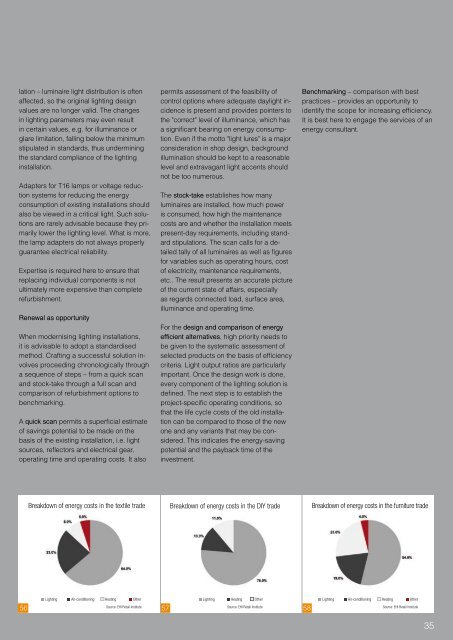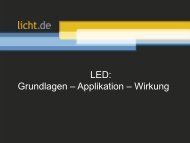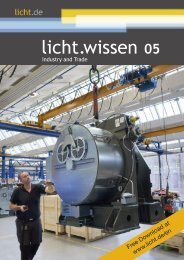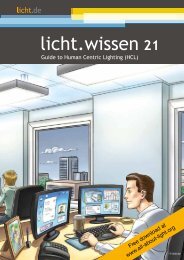licht.wissen No. 06 "Shop Lighting - Attractive and Efficient"
licht.wissen 06 provides a practical and user-oriented summary of attractive and efficient shop lighting. More information about professional lighting: www.licht.de/en
licht.wissen 06 provides a practical and user-oriented summary of attractive and efficient shop lighting. More information about professional lighting: www.licht.de/en
You also want an ePaper? Increase the reach of your titles
YUMPU automatically turns print PDFs into web optimized ePapers that Google loves.
lation – luminaire light distribution is often<br />
affected, so the original lighting design<br />
values are no longer valid. The changes<br />
in lighting parameters may even result<br />
in certain values, e.g. for illuminance or<br />
glare limitation, falling below the minimum<br />
stipulated in st<strong>and</strong>ards, thus undermining<br />
the st<strong>and</strong>ard compliance of the lighting<br />
installation.<br />
Adapters for T16 lamps or voltage reduction<br />
systems for reducing the energy<br />
consumption of existing installations should<br />
also be viewed in a critical light. Such solutions<br />
are rarely advisable because they primarily<br />
lower the lighting level. What is more,<br />
the lamp adapters do not always properly<br />
guarantee electrical reliability.<br />
Expertise is required here to ensure that<br />
replacing individual components is not<br />
ultimately more expensive than complete<br />
refurbishment.<br />
Renewal as opportunity<br />
When modernising lighting installations,<br />
it is advisable to adopt a st<strong>and</strong>ardised<br />
method. Crafting a successful solution involves<br />
proceeding chronologically through<br />
a sequence of steps – from a quick scan<br />
<strong>and</strong> stock-take through a full scan <strong>and</strong><br />
comparison of refurbishment options to<br />
benchmarking.<br />
A quick scan permits a superficial estimate<br />
of savings potential to be made on the<br />
basis of the existing installation, i.e. light<br />
sources, reflectors <strong>and</strong> electrical gear,<br />
operating time <strong>and</strong> operating costs. It also<br />
permits assessment of the feasibility of<br />
control options where adequate daylight incidence<br />
is present <strong>and</strong> provides pointers to<br />
the "correct" level of illuminance, which has<br />
a significant bearing on energy consumption.<br />
Even if the motto "light lures" is a major<br />
consideration in shop design, background<br />
illumination should be kept to a reasonable<br />
level <strong>and</strong> extravagant light accents should<br />
not be too numerous.<br />
The stock-take establishes how many<br />
luminaires are installed, how much power<br />
is consumed, how high the maintenance<br />
costs are <strong>and</strong> whether the installation meets<br />
present-day requirements, including st<strong>and</strong>ard<br />
stipulations. The scan calls for a detailed<br />
tally of all luminaires as well as figures<br />
for variables such as operating hours, cost<br />
of electricity, maintenance requirements,<br />
etc.. The result presents an accurate picture<br />
of the current state of affairs, especially<br />
as regards connected load, surface area,<br />
illuminance <strong>and</strong> operating time.<br />
For the design <strong>and</strong> comparison of energy<br />
efficient alternatives, high priority needs to<br />
be given to the systematic assessment of<br />
selected products on the basis of efficiency<br />
criteria. Light output ratios are particularly<br />
important. Once the design work is done,<br />
every component of the lighting solution is<br />
defined. The next step is to establish the<br />
project-specific operating conditions, so<br />
that the life cycle costs of the old installation<br />
can be compared to those of the new<br />
one <strong>and</strong> any variants that may be considered.<br />
This indicates the energy-saving<br />
potential <strong>and</strong> the payback time of the<br />
investment.<br />
Benchmarking – comparison with best<br />
practices – provides an opportunity to<br />
identify the scope for increasing efficiency.<br />
It is best here to engage the services of an<br />
energy consultant.<br />
Breakdown of energy costs in the textile trade Breakdown of energy costs in the DIY trade Breakdown of energy costs in the furniture trade<br />
4,0%<br />
4,0%<br />
4,0%<br />
4,0%<br />
23,0%<br />
4,0%<br />
4,0%<br />
23,0%<br />
4,0%<br />
4,0%<br />
23,0%<br />
4,0%<br />
23,0%<br />
23,0%<br />
23,0%<br />
23,0%<br />
23,0%<br />
54,0%<br />
54,0%<br />
54,0%<br />
<strong>Lighting</strong> Air-conditioning Heating Other<br />
<strong>Lighting</strong> Heating Other<br />
<strong>Lighting</strong> Air-conditioning Heating Other<br />
56 23,0% Source: EHI Retail Institute<br />
Source: EHI Retail Institute<br />
57 58<br />
19,0%<br />
54,0%<br />
54,0%<br />
19,0%<br />
54,0%<br />
54,0%<br />
19,0%<br />
23,0% Source: EHI Retail Institute<br />
54,0%<br />
Beleuchtung Klimatisierung Heizung Sonstiges<br />
Beleuchtung Klimatisierung Heizung Sonstiges<br />
Beleuchtung Klimatisierung Heizung Sonstiges<br />
19,0%<br />
19,0% 54,0%<br />
19,0% 19,0%<br />
19,0%<br />
35<br />
54,0%<br />
54

















